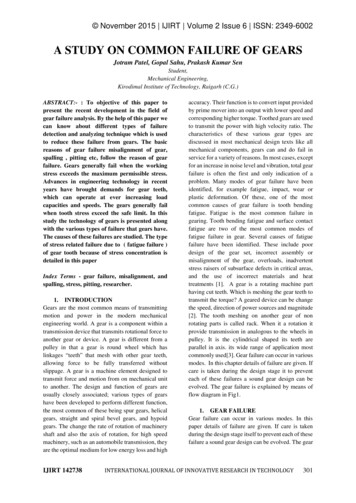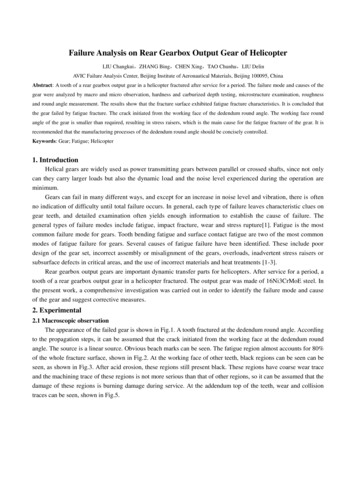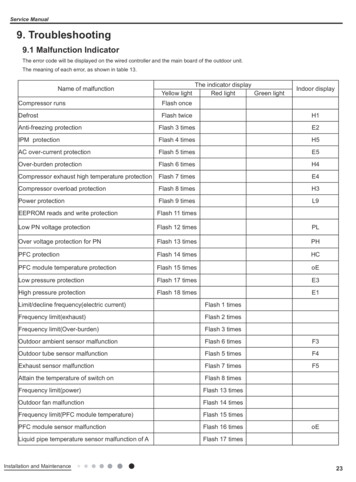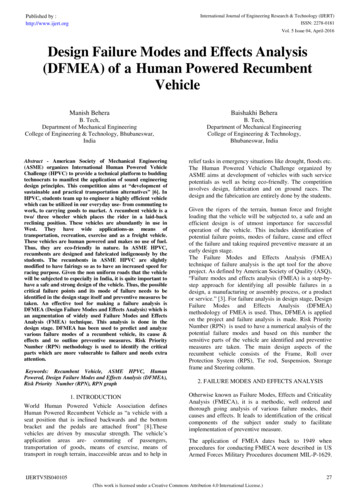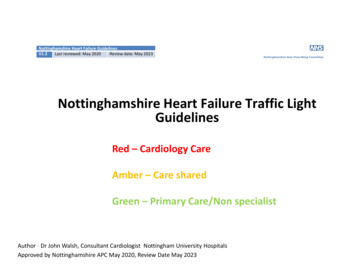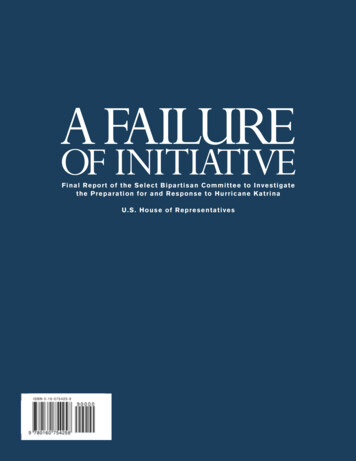
Transcription
AFAILUREOF INITIATIVEFina l R e p o r t o f t h e S e l ect Bipartisan Committee to Investigatet h e P r e p a r a t i o n f o r and Response to Hurricane KatrinaU . S . H ouse of Representatives4A FAILURE OF INITIATIVE
AFAILUREOF INITIATIVEFi n a l R e p o r t o f t h e S e l e c t Bipartisan Committee to Investigatet h e P r e p a r a t i o n f o r a nd Response to Hurricane Katrina
Union Calendar No. 00109th Congress2nd SessionReport000-000A FAILURE OF INITIATIVEFinal Report of the Select Bipartisan Committee to Investigatethe Preparation for and Response to Hurricane KatrinaReport by theSelect Bipartisan Committeeto Investigate the Preparationfor and Responseto Hurricane KatrinaAvailable via the World Wide Web: y 15, 2006. — Committed to the Committee of the Whole House on the State of the Union and ordered to be printedU. S. G O V E R N M E N T P R I N T I N G O F F I C EK e e p i n g A m e r i c a I n f o r m e d I w w w. g p o . g o vWA S H I N G T O N 2 0 0 623950 PDFFor sale by the Superintendent of Documents, U.S. Government Printing OfficeInternet: bookstore.gpo.gov Phone: toll free (866) 512-1800; DC area (202) 512-1800Fax: (202) 512-2250 Mail: Stop SSOP, Washington, DC 20402-0001COVER PHOTO: FEMA, BACKGROUND PHOTO: NASA
SELECT BIPARTISAN COMMITTEETO INVESTIGATE THE PREPARATION FOR AND RESPONSETO HURRICANE KATRINATOM DAVIS, (VA) ChairmanHAROLD ROGERS (KY)CHRISTOPHER SHAYS (CT)HENRY BONILLA (TX)STEVE BUYER (IN)SUE MYRICK (NC)MAC THORNBERRY (TX)KAY GRANGER (TX)CHARLES W. “CHIP” PICKERING (MS)BILL SHUSTER (PA)JEFF MILLER (FL)Members who participated at the invitation of the Select CommitteeCHARLIE MELANCON (LA)GENE TAYLOR (MS)WILLIAM J. JEFFERSON (LA)CYNTHIA MCKINNEY (GA)SHELIA JACKSON-LEE (TX)STAFF DESIGNATIONSDavid L. MarinJ. Keith AusbrookMichael GeffroyLawrence J. HalloranRobert BordenDaniel MathewsArthur WuThomas E. HawleyGrace A. WashbourneKim KotlarAnne Marie TurnerCharles M. PhillipsSteve CastorKim BaronofRisa SalsburgSusie SchulteShalley KimiiStaff DirectorSpecial CounselDeputy Special CounselDeputy Special CounselSenior Associate Special CounselSenior Professional StaffSenior Professional StaffSenior Professional StaffSenior Professional StaffSenior Professional StaffAssociate Special CounselAssociate Special CounselAssistant Special CounselProfessional StaffProfessional StaffProfessional StaffProfessional StaffWimberly FairChuck TurnerRobert WhiteDrew CrockettTeresa AustinAmy LaudemanRobin ButlerMichael SazonovPat DeQuattroJustin SwickElizabeth RyanStephen L. CaldwellBill MacBlaneBrooke BennettJay O’CallahanMichael ArkushMargaret PeterlinProfessional StaffSpecial InvestigatorPress SecretaryArt EditorChief ClerkDeputy ClerkAdministrative Officer/Financial AdministratorStaff AssistantCoast Guard FellowLaw ClerkLaw ClerkGAO DetaileeGAO DetaileeResearch AssistantResearch AssistantEditorial AssistantSpeaker’s DesigneeA FAILURE OF INITIATIVE
LETTER OF TRANSMITTALHOUSE OF REPRESENTATIVES,Washington, DC, February 15, 2006.Hon. J. Dennis Hastert,Speaker of the House of Representatives,Washington, DC.Dear Mr. Speaker: By direction of the Select Bipartisan Committee to Investigate thePreparation for and Response to Hurricane Katrina, I submit herewith the committee’sreport to the 109th Congress.Tom Davis,Chairman.A FAILURE OF INITIATIVEiii
ivA FAILURE OF INITIATIVE
“Pandemonium did not reign. It poured.”JOHN KENDRICK BANGSAmerican author and satirist“Five frogs are sitting on a log. Four decide to jump off.How many are left?Answer: five.Why? Because there’s a difference between deciding and doing.”MARK L. FELDMAN and MICHAEL F. SPRATTAmerican businessmenFive Frogs on a Log“Don’t find a fault. Find a remedy.”HENRY FORDAmerican automobile manufacturer“Hurricane Katrina was a force of Nature.What we’ve done after it is an Act of God.”Banner hanging in Harrison County, MS, Emergency Operations CenterFEMAIn-i-tia-tive, n.The power or ability to begin or follow through energetically with a plan or task;enterprise and determination.A FAILURE OF INITIATIVEv
viA FAILURE OF INITIATIVE
TABLE OF CONTENTSPrefaceixExecutive Summary of Findings1Investigation Overview7Background29Pre-landfall Preparation and Katrina’s Impact59Hurricane Pam81Levees87Evacuation103The National Framework for Emergency Management131FEMA Preparedness151Communications163Command and Control183The Military201Law Enforcement241Medical Care267Shelter and Housing311Logistics and Contracting319Charitable Organizations343Conclusion359AppendixA FAILURE OF INITIATIVE1 Glossary of Acronyms3652 HSOC Spot Report3743 White House Document Review3764 Emergency Grants to States3805 Key Federal Law Enforcement Activities3976 GAO Report4177 DHS Response to GAO Report4268 McKinney Supplement435vii
viiiA FAILURE OF INITIATIVE
PREFACEOn September 15, 2005, the House of Representatives approved H. Res. 437, which created the Select BipartisanCommittee to Investigate the Preparation for and Response to Hurricane Katrina (“the Select Committee”).According to the resolution, the Committee was charged with conducting “a full and complete investigation andstudy and to report its findings to the House not later than February 15, 2006, regarding— (1) the development,coordination, and execution by local, State, and Federal authorities of emergency response plans and other activities inpreparation for Hurricane Katrina; and (2) the local, State, and Federal government response to Hurricane Katrina.”The Committee presents the report narrative and the findings that stem from it to the U.S. House of Representativesand the American people for their consideration. Members of the Select Committee agree unanimously with the reportand its findings. Other Members of Congress who participated in the Select Committee’s hearings and investigationbut were not official members of the Select Committee, while concurring with a majority of the report’s findings, havepresented additional views as well, which we offer herein on their behalf.First and foremost, this report is issued with our continued thoughts and prayers for Katrina’s victims. Their families.Their friends. The loss of life, of property, of livelihoods and dreams has been enormous. And we salute all Americanswho have stepped up to the plate to help in any way they can.It has been said civilization is a race betweeneducation and catastrophe. With Katrina, we have hadthe catastrophe, and we are racing inexorably toward thenext. Americans want to know: what have we learned?Two months before the Committee was established,former Speaker of the House Newt Gingrich testifiedbefore a Government Reform subcommittee about theneed to move the government to an “entrepreneurial”model and away from its current “bureaucratic” model,so that we can get government to move with InformationAge speed and effectiveness.“Implementing policy effectively,” Speaker Gingrichsaid, “is ultimately as important as making the rightpolicy.”The Select Committee first convened on September 22,2005, understanding, like Speaker Gingrich, that a policythat cannot be implemented effectively is no policy at all.The Select Committee was created because, inthe tragic aftermath of Katrina, America was againconfronted with the vast divide between policy creationand policy implementation. With the life-and-deathdifference between theory and practice.The Select Committee has spent much of the past fivemonths examining the aftermath of this catastrophicdisaster. It has become increasingly clear that local,state, and federal government agencies failed to meetthe needs of the residents of Louisiana, Mississippi, andAlabama. It has been our job to figure out why, and tomake sure we are better prepared for the future.A FAILURE OF INITIATIVEOur mandate was clear: gather facts about thepreparation for and response to Katrina, at all levels ofgovernment.Investigate aggressively, follow the facts wherever theymay lead, and find out what went right and what wentwrong. Ask why coordination and information sharingbetween local, state, and federal governments was sodismal. Why situational awareness was so foggy, for solong. Why all residents, especially the most helpless,were not evacuated more quickly. Why supplies and equipment and support wereso slow in arriving. Why so much taxpayer money aimed at betterpreparing and protecting the Gulf coast was lefton the table, unspent or, in some cases, misspent. Why the adequacy of preparation and responseseemed to vary significantly from state to state,county to county, town to town. Why unsubstantiated rumors and uncriticallyrepeated press reports – at times fueled by topofficials – were able to delay, disrupt, and diminishthe response. And why government at all levels failed to reactmore effectively to a storm that was predicted withunprecedented timeliness and accuracy.ix
We agreed early on that the task before us was tooimportant for carping. This was not about politics.Katrina did not distinguish between Republicans andDemocrats.This was about getting the information we need tochart a new and better course for emergency preparationand response. The American people want the facts, andthey’ve been watching. They alone will judge whetherour review has been thorough and fair. Our final exam isthis report.Our report marks the culmination of 9 publichearings, scores of interviews and briefings, and thereview of more than 500,000 pages of documents.Our investigation revealed that Katrina was a nationalfailure, an abdication of the most solemn obligationto provide for the common welfare. At every level– individual, corporate, philanthropic, and governmental– we failed to meet the challenge that was Katrina. In thiscautionary tale, all the little pigs built houses of straw.Of all we found along the timeline running from thefictional Hurricane Pam to the tragically real devastationalong the Gulf coast, this conclusion stands out: ANational Response Plan is not enough.What’s needed is a National Action Plan. Not a planthat says Washington will do everything, but one thatsays, when all else fails, the federal government mustdo something, whether it’s formally requested or not.Not even the perfect bureaucratic storm of flaws andfailures can wash away the fundamental governmentalresponsibility to protect public health and safety.Still, no political storm surge from Katrina shouldbe allowed to breach the sovereign boundaries betweenlocalities, states, and the federal government. Our systemof federalism wisely relies on those closest to the peopleto meet immediate needs. But faith in federalism alonecannot sanctify a dysfunctional system in which DHSand FEMA simply wait for requests for aid that state andlocal officials may be unable or unwilling to convey. Inthis instance, blinding lack of situational awareness anddisjointed decision making needlessly compounded andprolonged Katrina’s horror.In many respects, our report is a litany of mistakes,misjudgments, lapses, and absurdities all cascadingtogether, blinding us to what was coming and hobblingany collective effort to respond.xThis is not to say there were not many, many heroes,or that some aspects of the preparation and responsewere not, by any standard, successful. We found manyexamples of astounding individual initiative thatsaved lives and stand in stark contrast to the largerinstitutional failures. Nor do we mean to focus onassigning individual blame. Obtaining a full accountingand identifying lessons learned does not require fingerpointing, instinctively tempting as that may be.There was also an element of simple bad luck withKatrina that aggravated the inadequate response. Thehurricane arrived over a weekend, at the end of themonth. People on fixed incomes had little money for gasor food or lodging, making them more likely to remainin place and wait for their next check. Communicatingvia television or radio with families enmeshed in theirweekend routines was difficult at best, as was findingdrivers and other needed volunteers.Over the past several months, we have become morethan familiar with the disaster declaration processoutlined in the Stafford Act. We understand the goals,structure and mechanisms of the National ResponsePlan. We’ve digested the alphabet soup of “coordinatingelements” established by the Plan: the HSOC(Homeland Security Operations Center) and RRCC(Regional Response Coordination Center); JFOs (JointField Offices) and PFOs (Principal Federal Officials); theIIMG (Interagency Incident Management Group); andmuch more.But the American people don’t care about acronymsor organizational charts. They want to know who wassupposed to do what, when, and whether the job gotdone. And if it didn’t get done, they want to know howwe are going to make sure it does the next time.This report is a story about the National ResponsePlan, and how its 15 Emergency Support Functions(ESFs) were implemented with Katrina. We offer detailson how well the ESFs were followed. Where therewere problems, we’ve asked why. Where even flawlessexecution led to unacceptable results, we’ve returned toquestioning the underlying plan.We should be clear about the limitations of ourinvestigation and the parameters of this report. Wefocused on the preparation for and response to Katrina,for the most part paring down the timeline to one weekbefore and two weeks after the storm. We did not, atA FAILURE OF INITIATIVE
least intentionally, delve into important, longer-termrebuilding and recovery issues that will continue to havea central place on the congressional agenda for monthsand years to come. In many areas — housing, education,health, contracting — “response” bleeds into “recovery,”and the distinctions we’ve made are admittedly difficultand somewhat arbitrary.Further, this report is only a summary of our work.We are hopeful that – indeed, certain that – moreinformation will arise. The Select Committee hasconstrained its narrative and findings to those that canshed the most light, make the biggest difference, andtrigger the most obvious near-term actions. Readers willnote that we focus considerable attention on a handfulof “key events” – evacuation plans and the executionof them; conditions and events at the Superdome,Convention Center, and highways; nursing homes andhospitals – as a means of illustrating what went rightand wrong in countless other locales.What this Select Committee has done is not rocketscience.We’ve gathered facts and established timelines basedon some fairly rudimentary but important questionsposed to the right people in both the public and privatesectors. What did you need and what did you get? Where were you in the days and hours rightbefore, during, and after the storm? Who were you talking to? What were you doing? Does that match what you were supposedto be doing? Why or why not?In other words, the Select Committee has matchedwhat was supposed to happen under federal, state, andlocal plans against what actually happened.Our findings emerged from this process of matching.Too often there were too many cooks in the kitchen,and because of that the response to Katrina was attimes overdone, at times underdone. Too often, becauseeverybody was in charge, nobody was in charge.Many government officials continue to stubbornlyresist recognizing that fundamental changes in disastermanagement are needed. This report illustrates that weA FAILURE OF INITIATIVEhave to stop waiting for the disaster that fits our responseplan and instead design a scalable capacity to meetwhatever Mother Nature throws at us. It’s not enoughto say, “We wouldn’t be here if the levees had notfailed.” The levees did fail, and government and otherorganizations failed in turn – in many, many ways.It remains difficult to understand how governmentcould respond so ineffectively to a disaster that wasanticipated for years, and for which specific direwarnings had been issued for days. This crisis was notonly predictable, it was predicted.If this is what happens when we have advancewarning, we shudder to imagine the consequences whenwe do not. Four and a half years after 9/11, America isstill not ready for prime time.This is particularly distressing because we know weremain at risk for terrorist attacks, and because the 2006hurricane season is right around the corner. With thisreport we hope to do our part to enhance preparationand response.With Katrina, there was no shortage of plans. Therewere plans, but there was not enough plan-ning.Government failed because it did not learn frompast experiences, or because lessons thought to belearned were somehow not implemented. If 9/11 was afailure of imagination, then Katrina was a failure ofinitiative. It was a failure of leadership.Tom DavisHarold RogersChristopher ShaysHenry BonillaSteve BuyerSue MyrickMac ThornberryKay GrangerCharles W. “Chip” PickeringBill ShusterJeff Millerxi
FEMAxiiA FAILURE OF INITIATIVE
EXECUTIVE SUMMARYOF FINDINGSThe Select Committee identified failures at all levels ofgovernment that significantly undermined and detractedfrom the heroic efforts of first responders, privateindividuals and organizations, faith-based groups, andothers.The institutional and individual failures we haveidentified became all the more clear when compared tothe heroic efforts of those who acted decisively. Thosewho didn’t flinch, who took matters into their ownhands when bureaucratic inertia was causing death,injury, and suffering. Those whose exceptional initiativesaved time and money and lives.We salute the exceptions to the rule, or, moreaccurately, the exceptions that proved the rule. Peoplelike Mike Ford, the owner of three nursing homes whowisely chose to evacuate his patients in PlaqueminesParish before Katrina hit, due in large part to his closeand long-standing working relationship with Jesse St.Amant, Director of the Plaquemines Office of EmergencyPreparedness.People like Dr. Gregory Henderson, a pathologistwho showed that not all looting represented lawlessnesswhen, with the aid of New Orleans police officers, heraided pharmacies for needed medication and suppliesand set up ad hoc clinics in downtown hotels beforemoving on to the Convention Center.But these acts of leadership were too few and farbetween. And no one heard about or learned from themuntil it was too late.The preparation for and response to HurricaneKatrina show we are still an analog government in adigital age. We must recognize that we are woefullyincapable of storing, moving, and accessing information– especially in times of crisis.Many of the problems we have identified can becategorized as “information gaps” – or at least problemswith information-related implications, or failures to actdecisively because information was sketchy at best. Betterinformation would have been an optimal weapon againstKatrina. Information sent to the right people at theright place at the right time. Information moved withinagencies, across departments, and between jurisdictions ofA FAILURE OF INITIATIVEgovernment as well. Seamlessly. Securely. Efficiently.Unfortunately, no government does these things well,especially big governments.The federal government is the largest purchaser ofinformation technology in the world, by far. One wouldthink we could share information by now. But Katrinaagain proved we cannot.We reflect on the 9/11 Commission’s finding that“the most important failure was one of imagination.”The Select Committee believes Katrina was primarilya failure of initiative. But there is, of course, a nexusbetween the two. Both imagination and initiative – inother words, leadership – require good information. Anda coordinated process for sharing it. And a willingness touse information – however imperfect or incomplete – tofuel action.With Katrina, the reasons reliable information didnot reach more people more quickly are many, and thesereasons provide the foundation for our findings.In essence, we found that while a national emergencymanagement system that relies on state and localgovernments to identify needs and request resourcesis adequate for most disasters, a catastrophic disasterlike Katrina can and did overwhelm most aspects of thesystem for an initial period of time. No one anticipatedthe degree and scope of the destruction the storm wouldcause, even though many could and should have.The failure of local, state, and federal governmentsto respond more effectively to Katrina — which hadbeen predicted in theory for many years, and forecastwith startling accuracy for five days — demonstrates thatwhatever improvements have been made to our capacityto respond to natural or man-made disasters, four andhalf years after 9/11, we are still not fully prepared. Localfirst responders were largely overwhelmed and unableto perform their duties, and the National ResponsePlan did not adequately provide a way for federal assetsto quickly supplement or, if necessary, supplant firstresponders.The failure of initiative was also a failure of agility.Response plans at all levels of government lackedflexibility and adaptability. Inflexible procedures often1
delayed the response. Officials at all levels seemed tobe waiting for the disaster that fit their plans, ratherthan planning and building scalable capacities tomeet whatever Mother Nature threw at them. Weagain encountered the risk-averse culture that pervadesbig government, and again recognized the need fororganizations as agile and responsive as the 21st centuryworld in which we live.One-size-fits-all plans proved impervious to clearwarnings of extraordinary peril. Category 5 needselicited a Category 1 response. Ours was a response thatcould not adequately accept civilian and internationalgenerosity, and one for which the Congress, throughinadequate oversight and accounting of state and localuse of federal funds, must accept some blame.In crafting our findings, we did not guidethe facts. We let the facts guide us. The SelectCommittee’s report elaborates on the followingfindings, which are summarized in part here, in theorder in which they appear:The accuracy and timeliness ofNational Weather Service andNational Hurricane Center forecastsprevented further loss of lifeThe Hurricane Pam exercisereflected regognition by all levelsof government of the dangers of acategory 4 or 5 hurricane strikingNew Orleans Implementation of lessons learned fromHurricane Pam was incomplete.Levees protecting New Orleanswere not built for the most severehurricanes Responsibilities for levee operations and maintenancewere diffuse. The lack of a warning system for breaches and otherfactors delayed repairs to the levees. The ultimate cause of the levee failures is underThe failure of complete evacuationsled to preventable deaths, greatsuffering, and further delays in relief Evacuations of general populations went relativelywell in all three states. Despite adequate warning 56 hours before landfall,Governor Blanco and Mayor Nagin delayed ordering amandatory evacuation in New Orleans until 19 hoursbefore landfall. The failure to order timely mandatory evacuations,Mayor Nagin’s decision to shelter but not evacuate theremaining population, and decisions of individualsled to an incomplete evacuation. The incomplete pre-landfall evacuation led todeaths, thousands of dangerous rescues, and horribleconditions for those who remained. Federal, state, and local officials’ failure to anticipatethe post-landfall conditions delayed post-landfallevacuation and support.Critical elements of the NationalResponse Plan were executed late,ineffectively, or not at all It does not appear the President received adequateadvice and counsel from a senior disasterprofessional. Given the well-known consequences of a majorhurricane striking New Orleans, the Secretary shouldhave designated an Incident of National Significanceno later than Saturday, two days prior to landfall,when the National Weather Service predictedNew Orleans would be struck by a Category 4 or5 hurricane and President Bush declared a federalemergency. The Secretary should have convened the InteragencyIncident Management Group on Saturday, twodays prior to landfall, or earlier to analyze Katrina’spotential consequences and anticipate what thefederal response would need to accomplish. The Secretary should have designated the PrincipalFederal Official on Saturday, two days prior tolandfall, from the roster of PFOs who had successfullyinvestigation, and results to be determined.2A FAILURE OF INITIATIVE
completed the required training, unlike then-FEMADirector Michael Brown. Considerable confusion wascaused by the Secretary’s PFO decisions. A proactive federal response, or push system, is not anew concept, but it is rarely utilized. The Secretary should have invoked the CatastrophicIncident Annex to direct the federal response postureto fully switch from a reactive to proactive mode ofoperations. Absent the Secretary’s invocation of the CatastrophicIncident Annex, the federal response evolved into apush system over several days. The Homeland Security Operations Center failedto provide valuable situational information to theWhite House and key operational officials during thedisaster. The White House failed to de-conflict varyingdamage assessments and discounted information thatultimately proved accurate.Massive communications damageand a failure to adequately planfor alternatives impaired responseefforts, command and control, andsituational awareness Massive inoperability had the biggest effect oncommunications, limiting command and control,situational awareness, and federal, state, and localofficials’ ability to address unsubstantiated mediareports. Some local and state responders prepared forcommunications losses but still experiencedproblems, while others were caught unprepared. The National Communication System met many ofthe challenges posed by Hurricane Katrina, enablingcritical communication during the response, butgaps in the system did result in delayed response andinadequate delivery of relief supplies. Federal agencies, including DHS, had varying degreesof unfamiliarity with their roles and responsibilitiesunder the National Response Plan and NationalIncident Management System. Once activated, the Emergency ManagementAssistance Compact enabled an unprecedented levelof mutual aid assistance to reach the disaster area in atimely and effective manner. Earlier presidential involvement might have resultedin a more effective response.DHS and the states were not preparedfor this catastrophic event While a majority of state and local preparednessgrants are required to have a terrorism purpose, thisdoes not preclude a dual use application. Despite extensive preparedness initiatives, DHS wasnot prepared to respond to the catastrophic effects ofHurricane Katrina. DHS and FEMA lacked adequate trained andexperienced staff for the Katrina response. The readiness of FEMA’s national emergency responseteams was inadequate and reduced the effectiveness ofthe federal response.A FAILURE OF INITIATIVECommand and control was impairedat all levels, delaying relief Lack of communications and situational awarenessparalyzed command and control. A lack of personnel, training, and funding alsoweakened command and control. Ineffective command and control delayed many reliefefforts.The military played an invaluable role,but coordination was lacking The National Response Plan’s Catastrophic IncidentAnnex as written would have delayed the active dutymilitary response, even if it had been implemented. DOD/DHS coordination was not effective duringHurricane Katrina. DOD, FEMA, and the state of Louisiana had difficultycoordinating with each other, which slowed theresponse. National Guard and DOD response operations werecomprehensive, but perceived as slow.3
The Coast Guard’s response saved many lives, butcoordination with other responders could improve. The Army Corps of Engineers provided criticalresources to Katrina victims, but pre-landfall contractswere not adequate. DOD has not yet incorporated or implementedlessons learned from joint exercises in militaryassistance to civil authorities that would have allowedfor a more effective response to Katrina. The lack of integration of National Guard and activeduty forces hampered the military response. Northern Command does not have adequate insightinto state response capabilities or adequate interfacewith governors, which contributed to a lack of mutualunderstanding and trust during the Katrina response. Even DOD lacked situational awareness of post-landfall conditions, which contributed to a slowerresponse. DOD lacked an information sharing protocol thatwould have enhanced joint situational awareness andcommunications between all military components. Joint Task Force Katrina command staff lackedjoint training, which contributed to the lack ofcoordination between active duty components. Joint Task Force Katrina, the National Guard,Louisiana, and Mississippi lacked neededcommunications equipment and the interoperabilityrequired for seamless on-the-ground coordination. EMAC processing, pre-arranged state compacts, andGuard equipment packages need improvement. Equipment, personnel, and training shortfalls affectedthe National Guard response. Search and rescue operations were a tremendoussuccess, but coordination and integration betweenthe military services, the National Guard, the CoastGuard, and other rescue organizations was lacking.The collapse of local law enforcementand lack of effective publiccommunications led to civil unrestand further delayed relief A variety of conditions led to lawlessness and violencein hurricane stricken areas. The New Orleans Police Department was ill-preparedfor continuity of operations and lost almost alleffectiveness. The lack of a government public communicationsstrategy and media hype of violence exacerbatedpublic concerns and further delayed relief. EMAC and military assistance were critical forrestoring law and order.
and response. The American people want the facts, and they've been watching. They alone will judge whether our review has been thorough and fair. Our final exam is this report. Our report marks the culmination of 9 public hearings, scores of interviews and briefings, and the review of more than 500,000 pages of documents.
